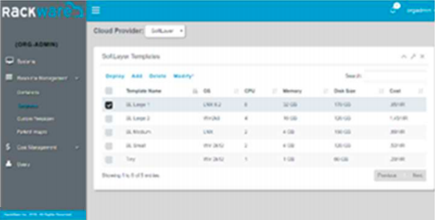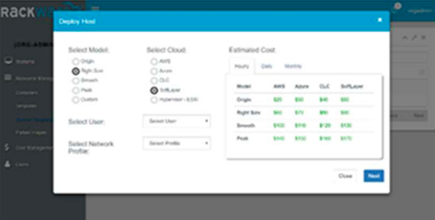Agility in a multi-cloud environment, with rapid deployment, a quick time-to-value, lowers IT expenses while optimizing application performance.
Analyze & Optimize Cloud Costs
Analyze and report usage and cost data from all clouds. Compare options, track budgets, pinpoint spending inefficiencies, and predict future costs.
Governance With Self-Service
Set guardrails around cloud use and access while giving users the flexibility of self-service within management approved capacity and budget limits.
A Single, Unified Platform
Manage public and private clouds as well as virtual and bare-metal servers, all through a single pane of glass.
Advanced Hybrid Cloud Management Suite
Managing private, public, and multi-cloud services is a challenge for I&O leaders. Enterprises that are successful in managing multi-cloud deployments are typically early technology adopters, embracing “New IT”, with technical expertise, mature processes, and centralized governance. The days of point products for every scenario are a thing of the past. I&O leaders embracing New IT are deploying solutions with a breadth of functionality across the broadest range of scenarios and technology.
RackWare’s Advanced Hybrid Cloud Management Suite provides agility in a multi-cloud environment, with rapid deployment, a quick time-to-value, lowering IT expenses while still optimizing application performance. It delivers economical multi-cloud / multi- tenant cloud computing to the Enterprise, allowing them to increase value to their customers while remaining competitive. The Suite is built on the RMM Platform. RMM has been used for years to replicate, mobilize, and protect enterprise applications in the cloud and data center. RMM provides proprietary replication technology, analytics, highly definable policy engines, and extensive API’s for integrating with existing applications and cloud stacks. With its automated policy engines, application development is accelerated and enables an easy path from test, development, to production. It provides reporting of usage statistics and predictive cost analysis, enabling automatic metered billing and ensuring cost management.
Cloud Governance
Manage Policies for Cost, Access, Image Templates
Governance, Monitoring, Metering, Reporting
Cost Monitoring
Golden Template Catalog
Activity Monitoring
The Suite’s Administrative Controls has complimentary functions, providing developers enough freedom and autonomy to work as they need, while providing administrators the appropriate controls for security, resource management, and cost controls. Administrators manage role based access, setting policies around user creation and read/write permissions to ensure protection of the Hybrid Cloud and applications. Setting resource pools, usage and resource limits, and intelligent triggers to scale up or down, the Suite’s park or un-park with comprehensive monitoring helps control wasted or abused web resources.
Cloud Costs
Variable Provisioning and Deployment Options
Cloud cost metering and billing
The Suite provides detailed analysis of workloads that provide information needed to make provisioning and deployment decisions delivering the best performance and cost savings. Aspects of a workload, including hardware, software, application metadata, networking, and storage, are collected in a discovery process. The performance and resource needs are monitored over time and analyzed to provide data that allows the application owner to choose the right provisioning model. Assessing cost management options can be done through, provisioning, deployment, and cloud modeling analytics providing right size deployments for each application’s workload balancing performance optimization and cost.
AutoParkingTM - AutoScaling
AutoParkingTM provides policy based provisioning and de-provisioning of servers in the cloud, optionally saving image state prior to a decommissioning event.
AutoScaling provides dynamic scaling of compute resources via a wide variety of configurable triggers, scaling up during periods of high activity and scaling down during periods of lower activity.
Cloud Brokerage and Migration
Cloud brokerage services allow users and organizations to provision applications and workloads across multiple clouds, including Amazon AWS, Azure, Google, IBM SoftLayer, and others. Cloud brokerage services show estimated cloud costs across public cloud providers, allowing the user to select deployment to the most appropriate cloud.
Cloud Service Management
Cloud Users set up approved cloud work space
Manage, Test, Distribute Golden Templates
The Suite’s self-service portal improves access and service to application owners. Supporting highly complex applications and environments, it delivers a high level of flexibility and granularity per workload. It supplies provisioning and deployment models to minimize compute resources while meeting performance objectives. Intelligent infrastructure provisioning as well as golden templates and customized templates enable rapid deployment while maintaining compliance and best practices.
Deployment & Cloud Provider Selection
Workload Deployment View
User System View
"We easily implemented and improved our disaster recovery strategy without buying additional hardware. We can now protect a larger number of workloads across our data center while increasing their availability. RackWare allows us to reduce downtime during an outage, with failover capabilities of complex and expensive high-availability solutions"
-Mark Kocour, Associate Principal Global IT, ZS Associates
















